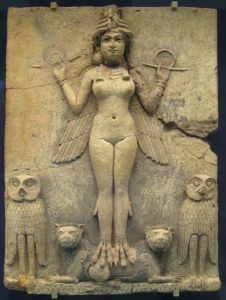 The Burney Relief, also known as the “Queen of the Night” relief, is of great significance to anyone interested in the context of Lilith in the ancient Mesopotamian culture. I agree with Richards assessment that this terracotta carving depicts Lilith, or Lilitu, as she was known before Judaism reinvented her.
The Burney Relief, also known as the “Queen of the Night” relief, is of great significance to anyone interested in the context of Lilith in the ancient Mesopotamian culture. I agree with Richards assessment that this terracotta carving depicts Lilith, or Lilitu, as she was known before Judaism reinvented her.
The nude goddess being flanked by two owls is what convinces me that this piece is specific to Lilith and not just Inanna or Ishtar. Though as Richard mentions in his post, I also believe that Inanna/Ishtar are linked with Lilith/Lilitu.
Also, the fact that she is carved with four sets of horns crowning her head is a good indicator that Lilith was of considerable status in the Akkadian pantheon.
This is just my theory, but I feel that Lilith/Lilitu was demonized over time; starting with the Sumerians, then the Hebrews added her to their mythology, and today we have the modern Christian iteration we are all so familiar with.
